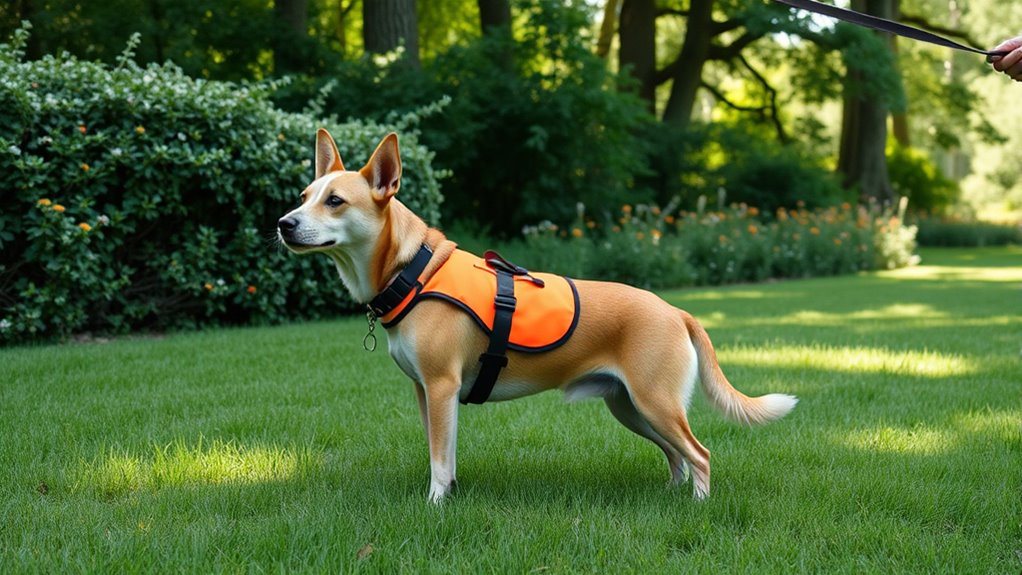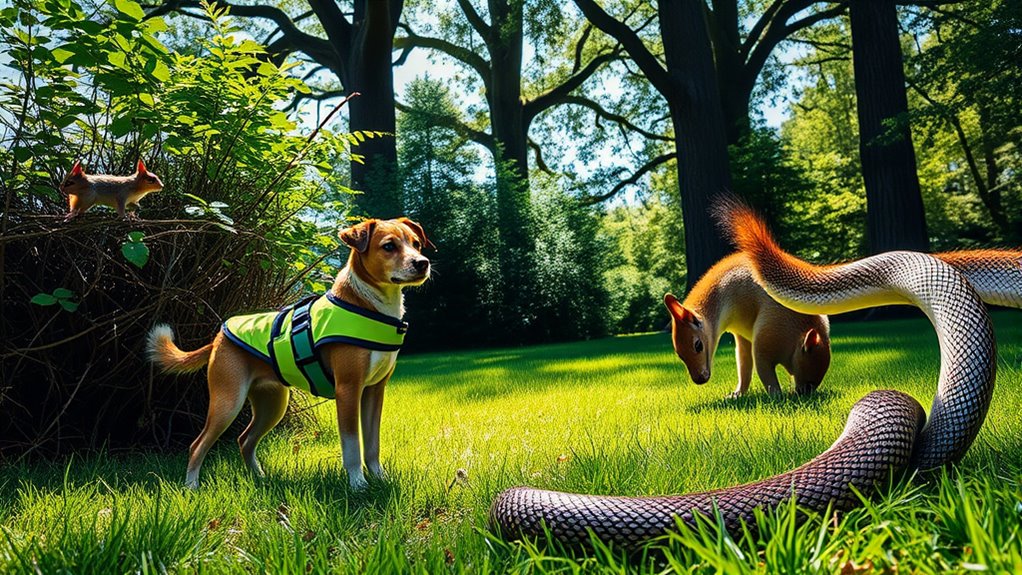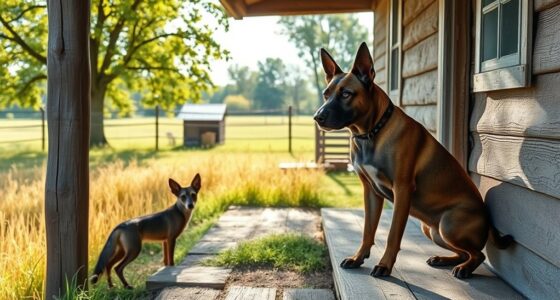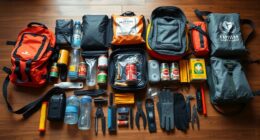To protect your pets from snake bites and wildlife dangers, keep them on a leash or in a secure area during outdoor activities, and clear your yard of tall grass, rocks, and debris where snakes hide. Regularly inspect your pets for pests like ticks, and use veterinarian-approved preventatives. Stay alert, supervise closely, and learn about local wildlife risks. If you want to discover more effective strategies and safety tips, there’s helpful information you should explore.
Key Takeaways
- Keep pets on a leash or within fenced areas to prevent encounters with snakes and wildlife.
- Regularly clear yard debris, tall grass, and rocks where snakes may hide.
- Supervise pets closely during outdoor activities, especially in high-risk habitats.
- Use veterinarian-approved tick and pest preventatives to reduce wildlife-related health risks.
- Be prepared with a first aid kit and know emergency procedures for snake bites.

As outdoor activities increase during warmer months, remaining vigilant to protect your pets from snake bites and other wildlife hazards is essential. During this time, snake safety should be at the top of your mind, especially if your pet enjoys exploring yards, trails, or wooded areas. Being aware of local wildlife and understanding the risks they pose can make all the difference in keeping your furry friend safe. Many snakes are harmless and avoid humans, but some, like rattlesnakes, copperheads, and water moccasins, can be dangerous if provoked or accidentally stepped on. You should always keep your pet on a leash or within a secure, enclosed area to minimize the chance of encounters with these reptiles.
Stay vigilant outdoors: keep your pet safe from snakes and wildlife hazards this season.
Practicing wildlife awareness means recognizing the types of animals that are common in your region and knowing how to respond if your pet comes into contact with them. For instance, if you notice snakes near your yard, clear away tall grass, piles of rocks, and debris where they may hide. Regularly inspecting your property and maintaining a tidy environment can greatly reduce the likelihood of wildlife intrusion. When you’re out on walks, keep your pet close and avoid thick brush or rocky areas where snakes might be hiding. If your pet is curious and tends to sniff around or paw at the ground, be extra cautious and watch their movements carefully.
In addition to snake safety, staying aware of other wildlife dangers is vital. Raccoons, skunks, and insects like ticks and fleas can pose health risks to your pet. Ticks, in particular, are common in grassy or wooded areas, and they can transmit diseases such as Lyme disease. Using veterinarian-approved tick prevention treatments and regularly checking your pet after outdoor adventures help keep these pests at bay. Also, be cautious around unfamiliar or aggressive animals, and never attempt to approach or feed wildlife, as this can provoke unpredictable behavior. Being informed about local wildlife and how to handle encounters can further enhance your pet’s safety.
Educating yourself about your area’s wildlife and staying alert during outdoor activities can prevent accidents before they happen. Always carry a basic first aid kit, including supplies for treating snake bites, and know how to respond quickly if your pet is bitten. Quick action can be lifesaving. Remember that some wildlife species are more active during certain times of day, so planning outdoor activities accordingly can reduce risks. Additionally, consulting with your veterinarian about vaccinations and preventive measures can provide extra protection for your pet. Properly understanding contingency plans for emergencies like snake bites can be critical in urgent situations. By maintaining good snake safety practices and fostering wildlife awareness, you can enjoy the outdoors with your pet while minimizing risks and ensuring their safety throughout the warmer months.
Frequently Asked Questions
What Signs Indicate My Pet Has Been Bitten by a Snake?
You wonder what snake bite symptoms and pet injury signs to watch for. If your pet suddenly shows swelling, redness, or pain around a bite area, it’s a red flag. Look for trembling, weakness, or difficulty breathing, which are serious signs. They may also be unresponsive or excessively drooling. Recognizing these warning signs early helps you seek prompt veterinary care, improving your pet’s chances of recovery.
How Can I Training My Pet to Avoid Wildlife Dangers?
You might think training your pet to avoid wildlife dangers isn’t possible, but with consistent effort, it is. Start with leash training to keep your pet close and safe. Incorporate recall exercises so they come back promptly when called. These techniques help your pet learn boundaries and stay away from risky wildlife. Regular training builds their confidence and awareness, reducing the chances of dangerous encounters outdoors.
Are There Specific Vaccinations to Protect Pets From Snake Venom?
You might wonder if there’s a pet vaccination for snake venom. Currently, there’s no universal vaccine, but a veterinarian can provide snake antivenom after a bite. While vaccination isn’t an option, you can reduce risks by keeping your pets away from snake habitats, and having a plan in case of a bite. Always consult your vet about the best ways to protect your pet from venomous snakes.
What Safe Outdoor Areas Minimize Wildlife Risks for Pets?
Wildlife worries weigh heavily on your mind. To minimize risks, choose safe fencing that keeps wild animals out and design shaded areas that discourage unwanted visitors. Opt for well-maintained yards with clear, clutter-free zones, and avoid tall grasses or dense bushes where snakes and critters hide. Regularly inspect outdoor spaces, and keep your pets close and calm. These simple steps create a safer, more secure sanctuary for your furry friends.
How Do I Prevent Wildlife From Entering My Yard?
To prevent wildlife from entering your yard, you should start with sturdy fencing barriers that are at least 4 feet high and buried a few inches underground. Regularly trim your yard landscaping to eliminate hiding spots and food sources, like fallen fruit or trash. Keep shrubs and tall grass away from fences to make your yard less inviting. These steps create a hostile environment for wildlife, reducing their chances of intrusion.
Conclusion
By being vigilant and proactive, you can prevent painful pet injuries from pesky pests and perilous predators. Keep your critters close, clear clutter, and stay cautious in wilderness areas. With care and caution, you can create a safe sanctuary where your pets are protected from sneaky snakes and wild threats. Remember, a little awareness and action go a long way in safeguarding your beloved companions from harm’s harsh hand. Stay alert, stay alive, and keep your pets happy and healthy.










